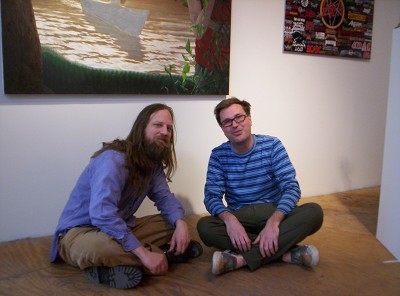Whitehot Magazine
October 2025
"The Best Art In The World"
"The Best Art In The World"
October 2025
March 07/ WM issue #1: Don Carroll of Jack the Pelican Presents, by Joe Heaps Nelson

Don Carroll
of
Jack the Pelican Presents
There was a group show in the next room, and a video soundtrack of screaming guys provided some ambient noise. It sounded like "Aaaaaaaaaaaaaaaaaaaaah! Aaaaaaaaaaaaaaaaaaaaaaah! ....Aaaaaaaaaaaaaaaaaaaaaaaaaaa
aaaaaaaaaaaaaaaaaaaaaaaaaaaaah!!!!!!!!!!!!!!!"
Heaps: whitehot magazine wants your general take on the New York art scene.
Don: Art is in a different time now. There are so many more artists than there used to be. Wherever you go there are hundreds. There are 50 -some galleries in Williamsburg.
Heaps: And hundreds in Chelsea.
Don: I was talking to a dealer the other day from Basel, and he said there are 30 galleries in Basel, and we have twice that many here in Williamsburg. It just reflects the fact that there are tens of thousands of artists here on the L train corridor, going into Brooklyn... It's like a cauldron of so many people doing stuff. Although they want to sell their paintings and everything, to some extent what artists really want is for other people to see their paintings! It's so depressing to sit in your studio and make work that nobody ever sees, they want to show, so all these venues sprung up here in Williamsburg. A lot of these galleries are clearly selling work. You can't survive with no sales at all, but it's not really about the money. In Chelsea, it's clearly about the money. Over there you've got dealers who are real professional salespeople who really know how to milk a collector, for a sale. I've seen it and I'm very impressed.
Heaps: Well you have amazing collectors over there, people who want to spend insane amounts of money.
Don: Oh yeah. It's neat because as there are more artists, there are more people buying art. For a long time, say in the 1970's, art had an elitist thing, where you walk into a gallery and see Robert Ryman's white paintings, and you say, "I don't get it!" Art nowadays speaks very directly to contemporary life. So anybody walking into a gallery for the most part, there is usually something you are going to "get". People catch the art bug.
Heaps: I would say the artists you show here have a lot of provocative imagery, and a lot of references to pop culture. It's like a second generation of pop art.
Don: That's a conversation that has come up a lot. At one time artists were using the pop idiom as a social critique. I'm not sure that's entirely true in the case of all those guys, but that's the way it was played, as a political agenda. Whereas nowadays, people have just digested the media as part of who they are. There's no self-conscious distancing from the norms of art. They are just making things that reflect the way they think and feel. It's honest. In some ways its kind of sad... What's the name of that television show? (Don indicates a collage of photographs from the show, and people in the gallery remember it's Saved by the Bell)
Somebody in the gallery: Oh, Saved by the Bell
“The thing I hate is people coming in a gallery or an art fair and being thumbs up or thumbs down. This sucks, that sucks. Come on who cares whether it sucks or not?”
Don: I stopped watching television at a certain point, it's weird, because I never watched that show, but everybody comes in here and says "Oh my God, Saved by the Bell."
People respond to each other, in relationships and everything, through this medium of pop culture. "What's your favorite TV program?" "What's your favorite band?" So that just becomes part of the climate in which people live. Certainly in Chris Bors' work there is a very self conscious kind of critique going on in there. He's interested specifically in a kind of white trash culture, the leavening of humanity that happens through this thing. His work in that sense is ironic in the way that pop was. If you take someone like Russell Nachman, those watercolors are pop in that they refer to a style of children's book illustration, and he specifically wanted to take that and raise it to an ambitious level, challenging the norms and conventions of traditional muscular painting. But there's nothing ironic in that. It's something that's much more sensitive. In his paintings you see references to Easy Rider, and Herbert Marcuse, One-Dimensional Man, and there's a genuine sense of loss.
Heaps: It's like an abandoned hippie landscape.
Don: That and a utopia, that's exactly what it is, but it's not pop... the contemporary sensibility is pop. People just think and feel in pop.
There's a lot of great art out there. It's wonderful to be involved in the art world, because every day is like Christmas. You get a submission and it's like wow! You are surprised! What is this going to be? But of those things that you see, so often it's there almost struggling to come out, but the artist doesn't seem to know it. Like you can't see yourself . For some reason people are blind to their own work. So I think it's really important that there should be a dialogue between artists.
Heaps: Do you mean a dialogue between pieces in the gallery?
Don: That's important certainly. I always think a group show is like a dinner party. Works addressing one another. I always thought it was strange in museums, there's one piece here and one piece there, and they don't seem to be aware of each other. So when you go into a group show and there's a rapport it's awesome. But I mean more that ...maybe this is my vanity because I'm an artist who doesn't have time to work...the collaboration that goes on between the gallery and the artist, the critics, the collectors... it's exciting . When someone is stubborn, and they don't want to participate in the dialogue, the work doesn't flower. I think people should trust each other more. And look at each other's work.The thing I hate is people coming in a gallery or an art fair and being thumbs up or thumbs down. This sucks, that sucks. Come on who cares whether it sucks or not? Why don't you try and enjoy it? Somebody put a lot of work into making that so that you could look at it, for free. If it doesn't speak to you, it doesn't speak to you, but I think it's more about that than about whether it's good or not. Everyone has this anxiety whether it's good or not good. If you target somebody and say that's good, and somebody else says no that sucks, that means you're stupid. Don't you know the official word on the street is that's bad art? Don't you get it? It has this weird snowball effect, where one person sees a show and says it was all right, and the other person feels empowered and says, you know what? That was a good show! Then they go to their third friend, and they now feel confident, because somebody else confirmed that this is a good artist, and they say hey that was a great show! Then they run into somebody else who says that show really sucked, and suddenly they are embarrassed, and they have some doubt and they pull back. It's funny how the street in that sense confers value... and sainthood. It's so much more interesting, rather than worrying about the status of a gallery or an artist, if you start looking at and engaging the work... because the imaginations of some of these kids will blow your mind. It enriches your world. You start having different kinds of dreams. “It's wonderful to be involved in the art world, because every day is like Christmas. You get a submission and it's like wow! You are surprised! What is this going to be?”
Heaps: It's an exciting time to be in New York, but then it always is.
Don: I think so, but if you think back to the eighties, it was so layered with pretension and attitude. So much of the art was all about that attitude.
Heaps: It was a smaller clique in those days
Don: Yeah, probably. There was a lot less opportunity. I was here in the east village scene, and it was pretty trashy, and everyone had attitude. It was either "street" attitude or "I'm rich" attitude. Nowadays I think people, even if they are rich, are just more honest. There's less pretension generally. People are generally connecting with the work and that's great. Maybe this is the point. I think that, a lot of artists might think, they are a gift from God. A lot of people think, Hey, my paintings are better than that guy who's showing over at blah-blah...
Heaps: Maybe you have to feel that way in order to keep going, because an art career is so full of disappointments!
Don: It's true, but ultimately if you are not making the work for your own pleasure, you shouldn't be doing it. Stop trying to prove something to the world that you matter. You matter anyway, because you are a person. The most valuable person in any given room is the person who's going to actually going to look at art. Look at the stuff for god's sakes.
http://www.jackthepelicanpresents.com/

Joe Heaps Nelson
Joe Heaps Nelson is an artist and writer in New York City.
http://www.joeheaps.com













